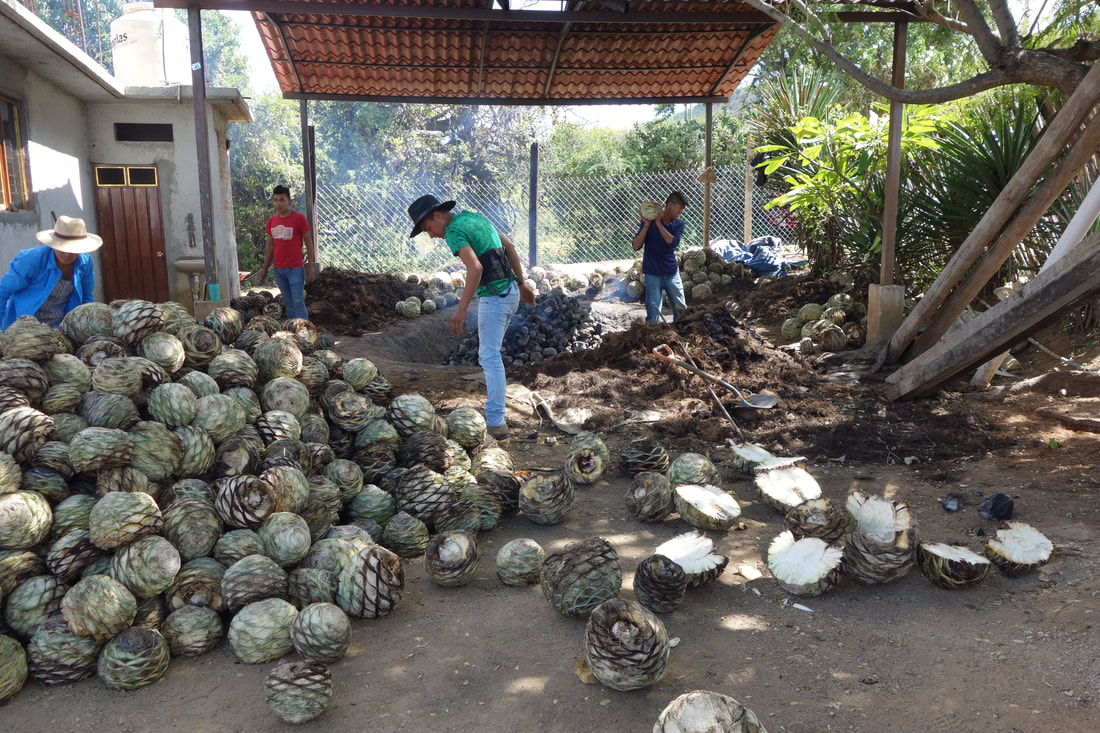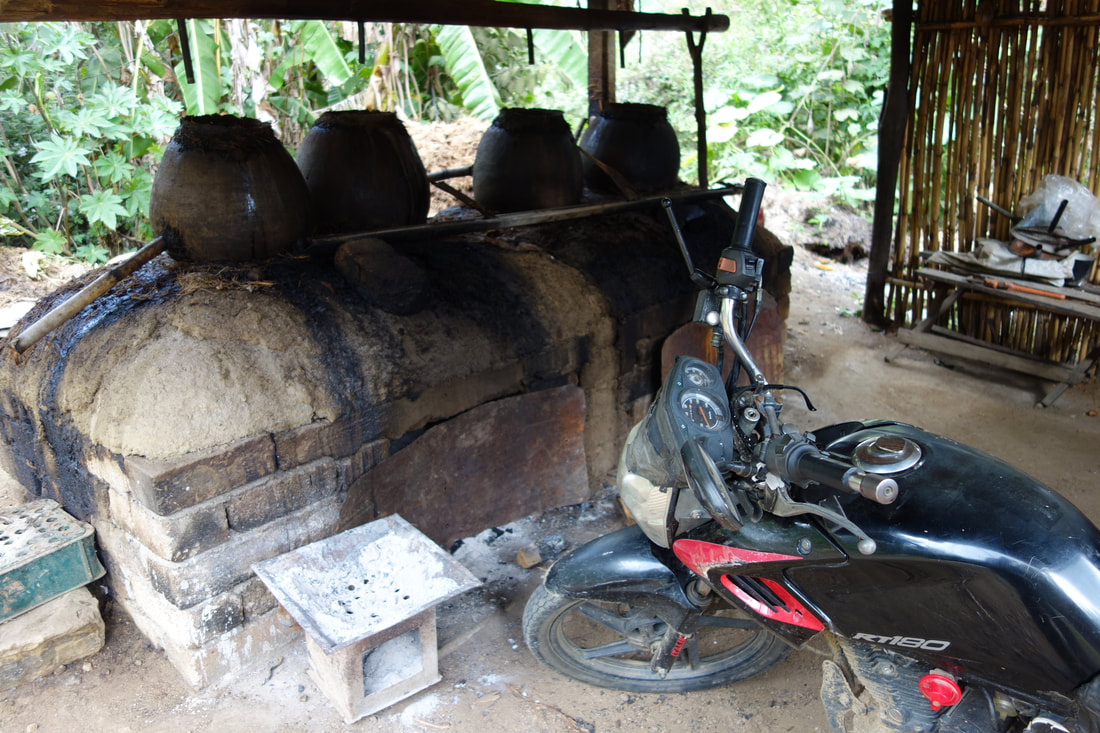|
Preparing the oven for baking Agave karwinskii Alvin Starkman, M.A., J.D. About a decade ago, beginning in the wake of the 2008/9 US economic crisis, the pattern of migration between the United States and the state of Oaxaca got turned on its head. To a significant extent it was because of the initial stages of the global mezcal boom. With Lidia Hernández of Mezcal Desde la Eternidad Depending upon which statistic one reads, Oaxaca is either the poorest, or the second poorest state in all Mexico next to Chiapas. We have agriculture, and we have tourism. While export of mangos, black beans, tomatoes and all the rest have been a relative constant over the years, tourism has not; and the state has relied on beach going and culture seeking visitors for much of its economic fortune. Preparing the oven to bake Agave potatorum Tourists from diverse corners of the globe would flock to Oaxaca for its Pacific sun and sand, cuisine, craft villages, archaeological sites, colonial architecture and quaintness. But they would stop coming, especially from the US due to State Department warnings and journalistic sensationalism, at the drop of a dime: the (Mexican) swine flu epidemic, the 2006 Oaxacan civil unrest, drug cartel activity no matter where in the country, zika, and the list goes on. Prospective visitors would eventually forget and again select the state for vacationing … until the next scare; tourism’s economic impact was characterized by peaks and valleys. Mezcal is distilled in clay pots here in San Bernardo Mixtepec To address this schizophrenia, Oaxacans, both skilled and otherwise, would leave the state, emigrating in search of the American dream, or simply relocating to Mexico City or other large commercial centers where work was always available. The former is elusive, and it became especially so when a decade ago both Americans and migrants began either losing their jobs or some of their week’s hours. It grew to be much more difficult for Mexicans to get by, let alone remit money home to family in Oaxaca. Preparing a copper alembic for a first distillation in Zimatlán Enter the bold new era of mezcal. Over the past several years, both its production and the agave spirit’s popularity on the world state, have literally been increasing exponentially. Statistics bear this out. Agave americana Reverse migration has addressed the first prong of the phenomenon, in part due to the American economic crisis. That is, Oaxacans who were losing their jobs in the US began returning to their rural homesteads to help their relatives make mezcal. In earlier times they were leaving towns and villages and they headed north, in droves. Now, with no or less work than before, they were coming home, and for good reason given the spike in production and sales of the agave distillate. Checking oven depth, first hand I personally know of three cases in the hinterland of Oaxaca where immigration into the US has changed to emigration back to Oaxaca; in Santiago Matalán, in San Dionisio Ocotepec, and in San Pablo Güilá. In two cases the direct motivation was to help the family produce mezcal for both domestic consumption and export since these Oaxacans were in need of good reliable labor. In the third case it involved a construction worker who in his youth learned to make mezcal in Oaxaca. He then lived in California as a laborer for 20 years, and now had an opportunity to return home and build and work at his very own traditional distillery, and construct a home. Vintage cántaros are highly collectible, and hard to come by Oaxacans in the lower classes and rural areas have always imbibed the spirit. But a new phenomenon began around the beginning of this decade, with middle class urbanites all of a sudden jumping on the bandwagon. It was the early stages of the boom in the US which has given Mexicans a sense of pride in mezcal, as a quality sipping spirit much like a good bourbon or single malt scotch, rather than as a gut wrenching way to get drunk quickly. Remember those college years? Enjoying a meal with Doña Reina Sánchez, maestra palenquera and good friend Now, mezcal is respected globally, and there is increasing worldwide demand for it. So more mezcal is being distilled for both national and international markets. And, with this popularity has come an influx of visitors; to learn about it either to increase personal knowledge or with a view to opening a mezcalería in their home cities, to film and photograph it for business purposes, to sample and buy it out of pure passion for the spirit, and to begin their own brands for export. This client insisted that she help crush the sweet, baked espadín (Agave angustifolia Haw) These pilgrims, from as far away as Australia, are not as deterred as the normal tourist by what their governments and media warn. Mezcal tourism is a constant, and growing. New bride from San Marcos Tlapazola, learns the ropes to help her Santiago matatlán husband The actual production of mezcal is both causing the return of Oaxacans to their homeland as indicated, and keeping Oaxacans here. However there is more; while the motivation of many travelers for visiting Oaxaca is for mezcal (i.e. learning, documenting and of course buying), the spirit is actually having a much broader positive impact on the state. That is, when visitors come for mezcal, they also buy crafts, take cooking classes, dine in restaurants, stay in hotels, visit archaeological sites, and the list goes on, and on, and on. The dramatic impact is that emigration from the state is either halted, or at minimum significantly curtailed. And this keeps families together, in all walks of life. Hard at work with the quiote in San Dionisio Ocotepec Alvin Starkman operates Mezcal Educational Excursions of Oaxaca (www.mezcaleducationaltours.com). He has been witnessing the metamorphosis from the beginning.
0 Comments
|
Archives
October 2022
Categories
All
|












 RSS Feed
RSS Feed
